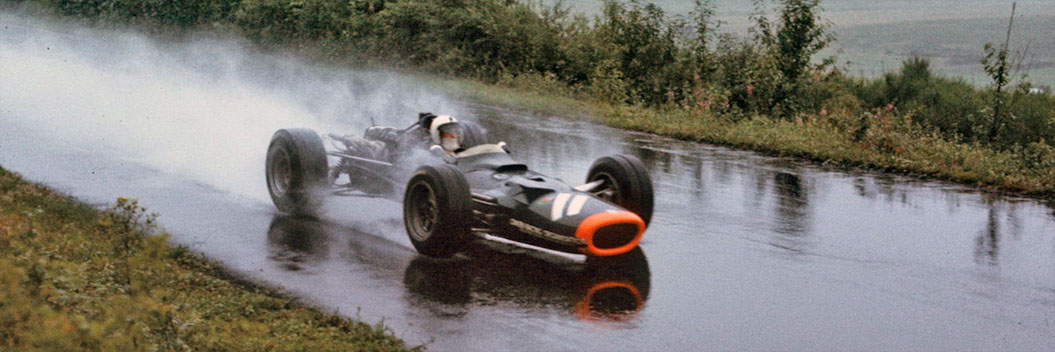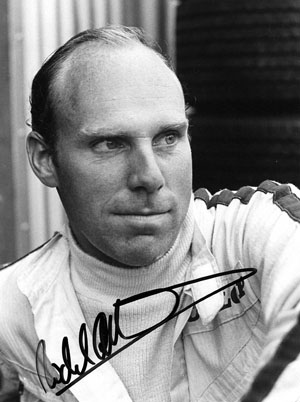Richard James David “Dickie” Attwood (born 4 April 1940, Wolverhampton, Staffordshire) is a British motor racing driver, from England. During his career he raced for the BRM, Lotus and Cooper Formula One teams.
He competed in 17 World Championship Grands Prix, achieved one podium and scored a total of 11 championship points. He was also a successful sports car racing driver and won the 1970 24 Hours of Le Mans race, driving a Porsche 917, the first of Porsche’s record 19 victories at the famous race. Info from Wiki
Bio by Stephen Latham
Richard ‘Dickie’ Attwood competed in 17 World Championship Grands Prix and during his career raced for BRM, Lotus and Cooper plus was a successful sports car driver and won the 1970 24 Hours of Le Mans .
His first car at 17 was a Standard 10, and he did a race at Goodwood in it, then a year of club racing in a Triumph TR3A until his father persuaded him to get a Formula Junior single seater. He and several other local FJunior drivers joined together and called themselves the Midland Racing Partnership, each driver owning his own car and employing his own mechanic. In 1962 his performance in the Monaco GP’s FJunior race brought him to people’s attention as he finished second in his heat behind Peter Arundell’s works Lotus, and in the final was running second to him again until his engine failed.
For 1963 MRP bought three Lola Juniors for Bill Bradley, David Hobbs and Richard and he immediately caught people’s attention when he raced the Lola Mk5a to victory in the Monaco Grand Prix Formula Junior support race, his smooth pace helping him to beat the Brabhams of Frank Gardner and Jo Schlesser. Unfortunately, at a later race at Albi he broke his leg in a crash when he ran wide on a fast right-hander though at the end of the year he was awarded the Grovewood Award, which was voted for by a Guild of Motoring Writers panel.
Following this, MRP moved up to F2 in 1964 and he won in Vienna and took second places in the Pau Grand Prix, Eifelrennen and Albi Grand Prix; this was when GP drivers drove in F2 and at Pau he was only beaten by reigning World Champion Jim Clark in a full-works Lotus. Richard and MRP team-mate Tony Maggs finished first and second in the Rome GP at Vallelunga, ahead of Jochen Rindt in third place. His performances prompted an offer of a a drive for the BRM F1 team and he drove the BRM P57 to fourth place in his first race, a non-Championship News of the World Trophy race at Goodwood. His second F1 race came in 1964’s British Grand Prix, where he drove BRM’s experimental four wheel drive P67 but though he managed to qualify the overweight car in last place the team withdrew it before the race.
He then drove for Reg Parnell’s Racing team for 1965 (with M.Hailwood) and took two sixth-place points finishes at Italy and Mexico towards the end of the season though was involved in a nasty accident at Spa in the rain. After hitting a river of water running across the road, he went sideways and then hit a telegraph pole but the pole wedged him into the cockpit, Fortunately he was conscious but was trapped in the car. There were a few spectators there and they came over and lifted the car away from the pole, but his feet were trapped as the front of the car had collapsed around them. He finally managed to escape, as the car went on fire, and burned for 20 minutes, and he luckily only sustained slight burns.
In 1966 he competed in Australia and New Zealand with BRM’s Tasman Series squad and took a victory at Levin. However despite his performances he missed the majority of the 1966 and 1967 F1 seasons and his only appearance came when he substituted for Pedro Rodríguez in a Cooper Maserati at 1967’s Canadian Grand Prix, finishing tenth. During 1966 he maintained his run of form in F2, taking victory in the Rome Grand Prix and a second place at Pau.
Richard rejoined the BRM works team in 1968, replacing Mike Spence after his tragic death during practice for the Indy 500. His return was spectacular, taking fastest lap in the Monaco Grand Prix and finished with a strong second place behind Graham Hill. During the race, the gear knob fell off and was rolling about in the cockpit and it took several laps before he could retrieve it it and screw it back on. However four races from the end of the season he was himself replaced by Bobby Unser.
His final F1 start came at 1969’s Monaco GP when he substituted for an injured Jochen Rindt and he took the Lotus 49B to a respectable fourth-place finish. Although it was his last F1 drive he did race Frank William’s F2 Brabham at the 1969 German GP and finished sixth overall; second in the F2 class.
Alongside his early F1 racing, he had also been offered a Ford sports car contract and his first race was in a Shelby Cobra in the Nürburgring 1000 Kms, with Jo Schlesser. Unfortunately most of the Cobras crashed or broke and after various stops to do repairs, they eventually finished twenty third, winning the class and earning the points for Ford.
At Le Mans he had his first race in a Ford GT (with J.Schlesser) but on the Mulsanne Straight he saw flames in his mirror. He tried keeping the throttle fully open in the hope it would suck the flames back in and put the out the fire out but he eventually had to stop and then watch it burn. His first major international win was in South Africa at the 1964 Rand 9 Hours race, driving David Piper’s Ferrari P2 and he drove for him many times over the following years, including Le Mans in 1966.
Driving for the Maranello Concessionaires team, there was a third place finish in the Spa 1000 km and second in the 500km Zeltweg in 1967. There were other drives in a Porsche 906 and Alfa Romeo T33 plus he was one of the few drivers to race the Ford P68, (successor to the GT40), but failed to finish the 1968 Nürburgring 1000km race due to mechanical problems.
For the 1967 Le Mans race he was teamed with Piers Courage but finally finished Le Mans for the first time in 1968, in seventh place with David Piper’s 275LM .
In 1968 he drove Alan Mann’s Ford F3L sports car and took pole for the Tourist Trophy at Oulton Park, though retired on lap 10 when the differential failed. However, David Piper had nominated him as reserve driver, so when the F3L stopped he took over the Ferrari and finished second, behind Denny Hulme in a Lola T70.
For the 1969 World Sportscar Championship season he had good offers, including one of John Wyer’s Gulf GT40, but eventually signed with the Porsche works team plus was involved in the development of the Porsche 917. He and Vic Elford finished second in the BOAC 500 in a 908 drove then drove a 917 at Le Mans, but after leading for a large part of the race, the car suffered a gearbox failure after 20 hours.
He teamed for the following year’s race with Hans Herrmann and they were in the lead by 2am, and stayed in front for 14 hours to take the victory. However Richard was very unwell at the time and unable to eat or drink due to a sore throat and swollen glands and afterwards missed the victory celebrations and retired to bed; it was later diagnosed as mumps. He also became involved in Steve McQueen’s Le Mans movie and they were still there in November as they changed scriptwriters, changed directors and it went hugely over schedule and over budget. He and Mike Parkes used to eat with him and said how he didn’t want to talk about movies, just about racing, and was a genuine, knowledgeable racing buff.
He did fewer races in 1971 though raced for John Wyer at Le Mans, with Herbie Muller as co-driver. During it they were leading at half-distance when the car jammed in gear and it took some time to fix but they finished second behind H.Marko/G.Van Lennep’s 917. He also drove at the Osterreichring 1000 Kms though team mate Pedro Rodriguez did 157 of its 170 laps and commented on Pedro’s constitution, as after he was brought in after driving for three hours, Richard got in the car, and after Pedro rested for a few minutes, said he was ready to get back in the car. They won the race by two laps.
After he retired, he was persuaded to do Le Mans in 1984 with the Aston Martin Nimrod team but it proved disappointing. While co-driver John Sheldon was in the car he had a big accident and the car was destroyed but the second Aston Martin hit the wreckage and both cars were out.
He is still much in demand as a historic racer, often appearing at Goodwood, in others’ cars as well as his own BRM P261 and was involved with Porsche, Ferrari and Audi, giving demonstrations and track-day tuition. In 2017 he raced a Porsche 928 in the HSCC 70s Road Sports Championship, only the second time he had raced a 928, having raced a Bromos 928 at the Daytona 24 Hours in 1984 (with Vic Elford, Howard Meister and Bob Hagestad).
Info A GP fluke, a hillclimb winner ![]()




